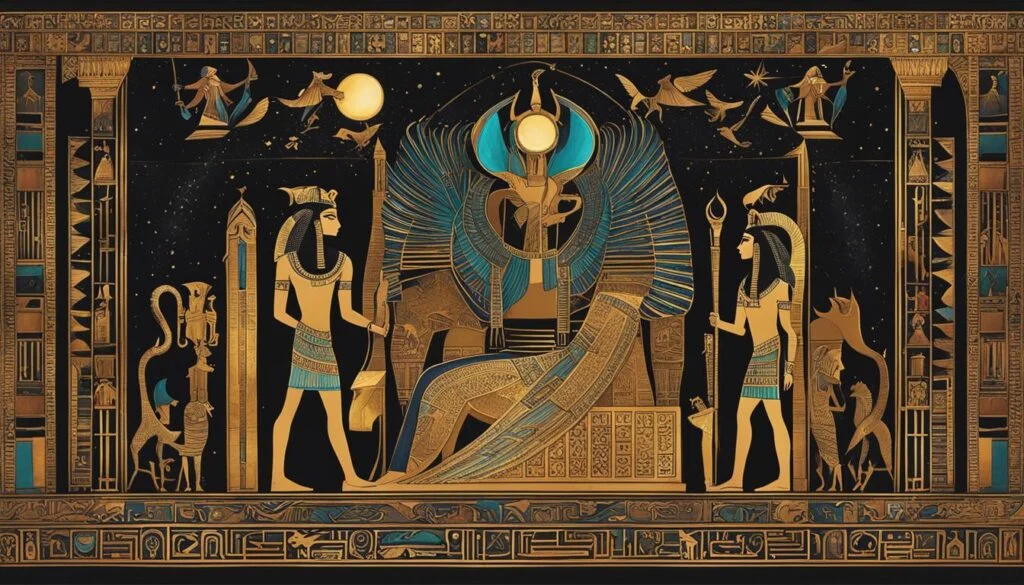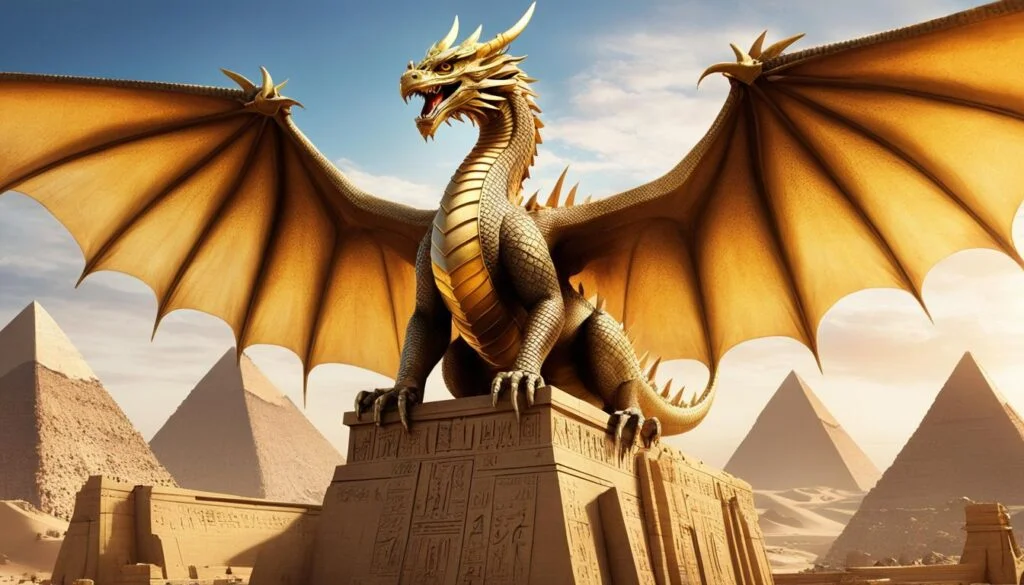In ancient Egyptian mythology, the belief in different realms beyond the mortal world was deeply ingrained in their religious practices. These realms, also known as dimensions, were believed to be inhabited by various gods and goddesses who governed and influenced different aspects of life and nature. Understanding the concept of realms in Egyptian mythology is vital for gaining insight into their rich cultural heritage and worldview.
In this article, we will delve into the fascinating world of Egyptian mythology and uncover the number of realms that existed according to their religious beliefs. From the role of gods and goddesses to the power of demons, we will explore the diverse dimensions intertwined in the Egyptian cosmology.
Key Takeaways:
- Egyptian mythology encompassed the belief in multiple realms beyond the mortal world.
- Gods and goddesses represented different aspects of these realms and held significant roles in Egyptian mythology.
- Demons were considered powerful beings in Egyptian mythology, with Ammut and Apepi being prominent examples.
- Many Egyptian gods and goddesses were depicted with a combination of human and animal features.
- The Egyptian pantheon consisted of numerous deities, each representing different aspects of life and nature.
The Role of Gods and Goddesses in Egyptian Mythology
In ancient Egyptian mythology, gods and goddesses held immense significance. They were believed to embody various natural and supernatural elements and were revered as the controllers of different realms and forces. The gods and goddesses of ancient Egypt played a crucial role in shaping the belief systems and understanding of the Egyptians, guiding them in matters of life and death.
The pantheon of ancient Egyptian gods and goddesses consisted of a diverse range of deities, each possessing unique attributes and responsibilities. These divine beings were worshipped and revered, with elaborate temples and rituals dedicated to their honor. The Egyptians believed that by appeasing these gods and goddesses, they could gain favor and protection in both the mortal realm and the afterlife.
One of the central concepts in ancient Egyptian mythology was the belief in an afterlife, where the soul would journey after death. The gods and goddesses were believed to play a crucial role in this journey, acting as guides and judges in the complex process of judgment and rebirth.
Depictions of these gods and goddesses can be found in countless ancient Egyptian artifacts, such as temple reliefs, sculptures, and hieroglyphic texts. These visual representations often featured gods and goddesses with human bodies and animal heads, symbolizing their connections to specific realms or aspects of nature.
Gods and Goddesses Associated with the Afterlife
- Anubis: The jackal-headed god associated with embalming and the weighing of the heart in the judgment of the dead.
- Osiris: The god of the dead and the ruler of the underworld, associated with resurrection and rebirth.
- Maat: The goddess of truth, justice, and cosmic order, who ensured a fair judgment in the afterlife.
- Isis: The goddess of magic and motherhood, who played a vital role in the resurrection of Osiris and the protection of the deceased.
The rich mythology surrounding the gods and goddesses of ancient Egypt continues to captivate people around the world. These divine beings serve as a testament to the ancient civilization’s intricate belief systems and their profound reverence for the forces that shaped their existence.
The Power of Demons in Egyptian Mythology

In Egyptian mythology, demons held significant power, although they were not as mighty as the gods. Among the prominent demons in ancient Egypt were Ammut and Apepi.
Ammut
Ammut, known as the Devourer of the Dead, played a crucial role in the afterlife. This fearsome demon featured the head of a crocodile, the front legs and torso of a lion, and the hind legs of a hippopotamus. Ammut dwelled by the scales of justice in the Hall of Ma’at.
During the judgment of the deceased’s soul in the afterlife, Ammut awaited the wicked. If their hearts were found to be heavier than the feather of Ma’at, she would devour them, ensuring their eternal punishment.
Apepi
Apepi, also known as Apophis, was an adversary of the sun god, Ra. Depicted as a colossal snake, Apepi represented chaos and evil in ancient Egyptian mythology. Every night, Apepi attempted to prevent the sun god from completing his journey across the sky.
The Egyptians believed that their priests needed to appease and repel Apepi to ensure the sun’s safe passage during the night. The rituals performed to counter Apepi’s influence were vital for maintaining cosmic order and preventing chaos from disrupting the divine balance.
These powerful and intriguing demons in Egyptian mythology exemplified the belief in the supernatural forces that influenced various aspects of life and death in ancient Egypt.
The Physical Forms of Egyptian Gods and Goddesses
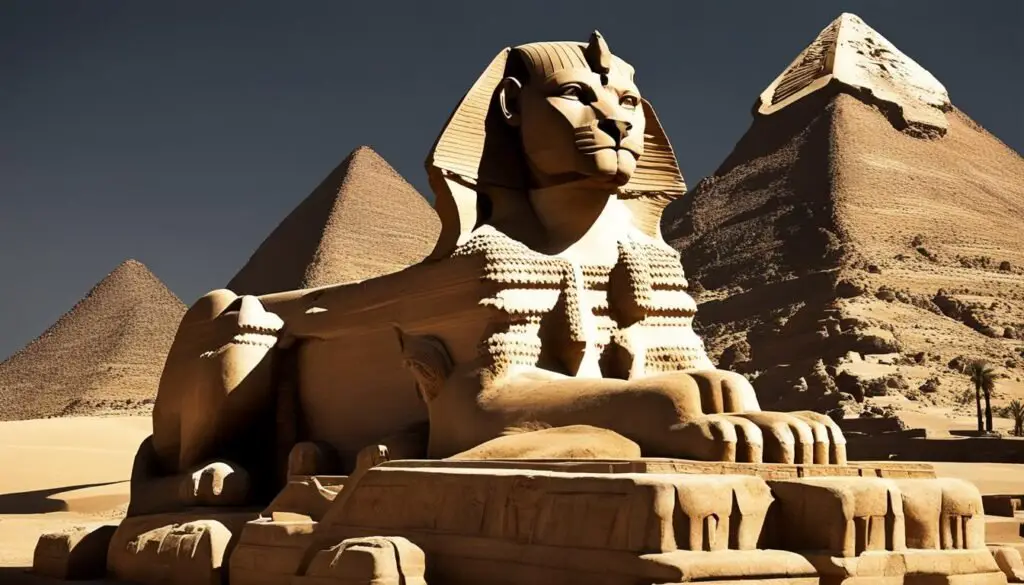
In ancient Egyptian mythology, the gods and goddesses were often depicted with a fascinating blend of human and animal features. These unique physical forms held deep symbolic significance and helped convey the gods’ attributes, characteristics, and associations.
The gods and goddesses were frequently represented as having a human body with the head of a specific animal, creating a distinctive visual representation of their divine nature. This portrayal allowed the Egyptians to connect the gods to the natural world and understand their roles in the grand scheme of their mythology.
One of the most iconic examples of these animal-headed gods is the Sphinx. This legendary creature features the head of a human and the body of a lion. The Sphinx holds great significance in Egyptian mythology and often symbolizes wisdom, strength, and guardianship.
Animal-Headed Gods
Among the numerous animal-headed gods in Egyptian mythology, some of the most prominent include:
- Horus: The falcon-headed god associated with the sky and protection
- Anubis: The jackal-headed god of mummification and the afterlife
- Bastet: The lioness-headed goddess of protection and joy
- Thoth: The ibis-headed god of wisdom, writing, and magic
- Sekhmet: The lioness-headed goddess of war and healing
These animal-headed gods played significant roles in Egyptian mythology, representing various aspects of life, nature, and the divine.
Major Egyptian Gods and Goddesses
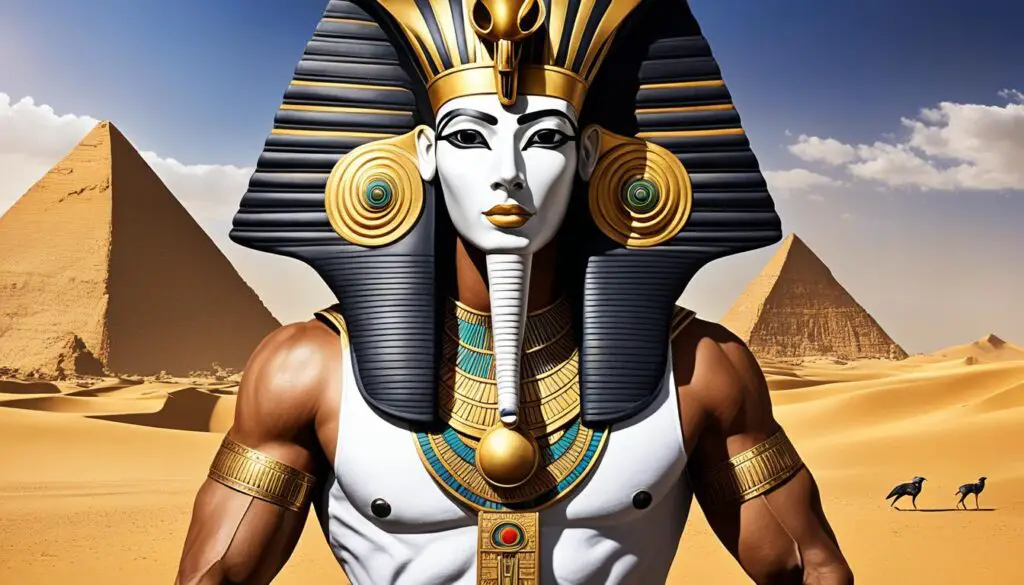
The rich tapestry of Egyptian mythology is woven with a diverse pantheon of gods and goddesses, each embodying different facets of life and nature. Let’s explore some of the major deities that were revered by the ancient Egyptians:
- Amun: Known as the creator god, Amun was associated with the air and hidden forces of the universe.
- Ra: Considered the sun god and a symbol of creation and life, Ra was worshipped as the ruler of the heavens.
- Osiris: Revered as the god of justice and the afterlife, Osiris played a pivotal role in Egyptian funerary rituals.
- Isis: The goddess of motherhood and magic, Isis was deeply revered and seen as a protector of the pharaoh and the people.
- Horus: As the god of the sky and symbolized by a falcon, Horus was associated with kingship and represented divine authority.
- Hathor: Hathor was the goddess of love, beauty, and drunkenness, often portrayed as a nurturing figure and associated with fertility.
- Anubis: Anubis, the jackal-headed god, was the guardian of the dead and guided souls through the afterlife.
- Seth: Known as the god of chaos and deception, Seth represented the turbulent side of nature and was often associated with storms and disorder.
- Nut: Nut was the goddess of the earth and the sky, symbolizing the vastness and nurturing essence of the cosmos.
- Geb: Geb was the god of fertility, representing the fertile earth. He was often portrayed lying beneath Nut, signifying the union of heaven and earth.
The worship of these gods and goddesses played a vital role in the religious and spiritual practices of ancient Egypt. Their stories and roles provided the Egyptians with a framework to understand the world around them and navigate the complexities of life.
As we delve deeper into the realms of Egyptian mythology, we unravel the intricate tapestry of gods and goddesses that shaped the ancient Egyptian civilization.
Ancient Egyptian Astronomical Records
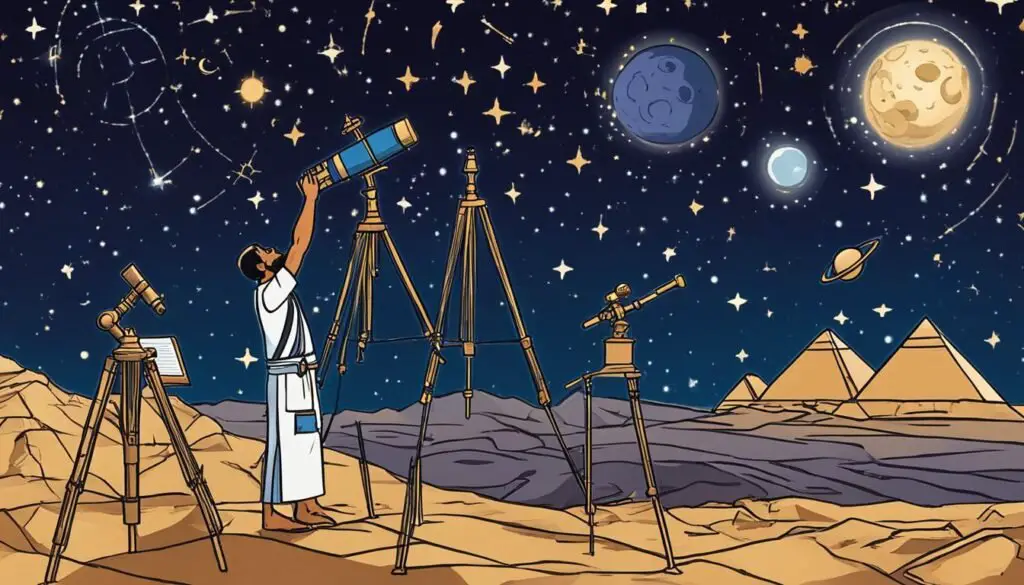
In ancient Egypt, the study of astronomy played a crucial role in understanding the cosmos and its relationship with the divine. The ancient Egyptians meticulously recorded their astronomical observations on various artifacts, including coffin lids, offering intriguing insights into their knowledge of the stars. These records, known as ancient Egyptian astronomical records, take the form of elaborate star charts that depict the movements of selected stars throughout the year.
Archaeologists first discovered these remarkable star charts in the late 19th century, unveiling a wealth of information about the ancient Egyptians’ fascination with the night sky. These charts provide a unique window into the astronomical practices of this ancient civilization, offering valuable insights into their celestial observations.
The Significance of Ancient Egyptian Star Charts
Ancient Egyptian star charts served as both scientific and religious tools. These meticulously crafted records allowed the Egyptians to track and predict celestial events, aiding their navigational skills and agriculture. They meticulously observed the celestial bodies, noting their positions and movements with remarkable accuracy.
The intricate designs on these star charts also suggest a deeper religious significance. The Egyptians believed that the stars and planets were divine entities connected to their gods and perhaps even influenced the rhythm of life on Earth. These charts served as visual representations of their complex cosmological beliefs, merging the realms of science and religion.
Exploring the Ancient Egyptian Star Chart
The ancient Egyptian star charts boast astonishing complexity and attention to detail. The charts were organized into columns and rows, representing the passage of time. Each column symbolized a week, while each row denoted an hour of the night. This structured approach allowed the Egyptians to track the celestial bodies with precision.
- These star charts prominently featured decans—individual stars or small clusters of stars that rose over the eastern horizon throughout the year. The decans were critical markers used by the Egyptians to track the progress of time during the night and the changing seasons.
- One fascinating feature of the ancient Egyptian star charts is the depiction of a triangle of decans. This triangle indicates that the Egyptians made real astronomical observations rather than relying solely on symbolic representations.
The presence of these decans and their intricate patterns on the star charts attests to the ancient Egyptians’ advanced knowledge of the night sky. Their ability to accurately map the movements of celestial bodies demonstrated a remarkable understanding of astronomy for their time.
However, interpreting these ancient Egyptian star charts poses challenges for modern scholars. The existence of two distinct groups of star charts, with variations in decan patterns, has sparked debates and alternative explanations. Inconsistencies in the order of appearance of certain decans further add to the complexity of deciphering these complex cosmological records.
Unraveling the Secrets of Ancient Egyptian Astronomy
Studying the ancient Egyptian star charts continues to fascinate and challenge researchers. As scholars delve deeper into the complexities of these celestial records, they seek to unravel the mysteries of ancient Egyptian astronomy and gain a deeper understanding of the civilization’s beliefs and scientific achievements.
The ancient Egyptian astronomical records provide a remarkable testament to the intricate knowledge of the stars and the cosmos held by this ancient civilization. These star charts offer glimpses into the ancient Egyptians’ quest for understanding their place in the universe and the profound connections they believed existed between the divine and the natural world.
The Function of Ancient Egyptian Star Charts
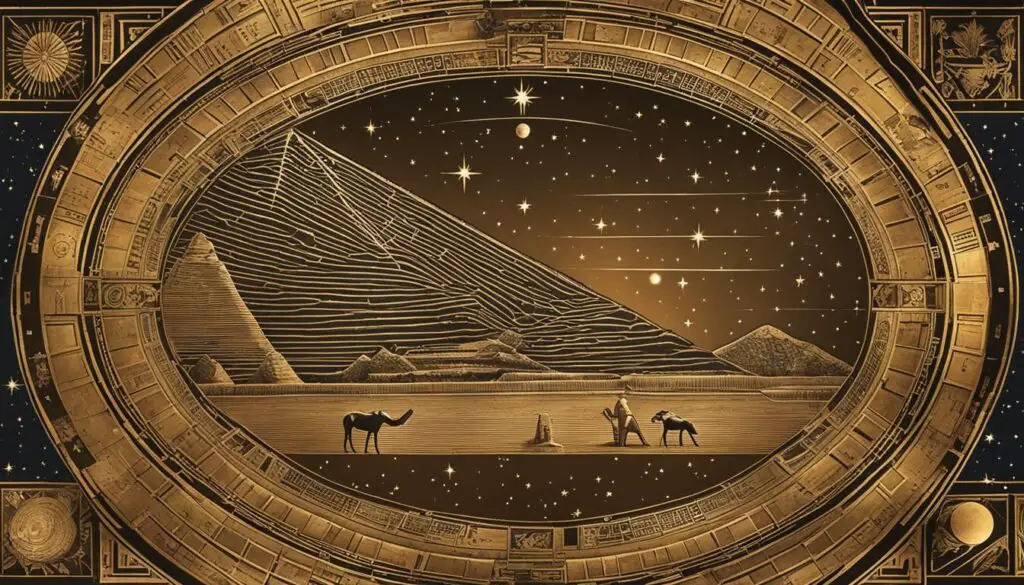
Scholars have proposed different theories regarding the function of ancient Egyptian star charts. One hypothesis suggests that they were used as star clocks to determine time during the night. Another theory suggests that they were related to religious rituals performed by priests to mirror the sun’s dangerous journey through the night. The star charts were intricately designed with detailed depictions of star names and celestial objects.
Ancient Egyptian star charts served a dual purpose, combining practical timekeeping and religious symbolism. The precise positioning and labeling of stars allowed for accurate tracking of time during the night, aiding in activities such as navigation and astronomy. These charts were also deeply connected to the Egyptian’s religious beliefs and rituals.
Star Clocks for Timekeeping
- The star charts were organized in a way that facilitated timekeeping during the night. By observing the positions of specific stars, the ancient Egyptians could determine the current hour.
- Various decans, or specific groups of stars, were assigned to each hour. As the night progressed, different decans would rise above the horizon, indicating the passing of time.
- These star clocks were likely used by astronomers, astrologers, and priests for practical purposes like predicting celestial events and conducting religious ceremonies at specific times.
Religious Symbolism and Rituals
However, these star charts were not solely used for timekeeping. They were deeply intertwined with the ancient Egyptian religious beliefs and rituals.
- The movement of stars was believed to mirror the journey of the sun through the underworld, and the star charts were used to replicate this hazardous journey during religious rituals.
- The priests would perform ceremonial rites throughout the night, closely following the positions of the stars depicted on the charts to guide their actions.
- These rituals were crucial for ensuring the sun’s successful return and the continuation of life. The star charts served as a symbolic representation of the sun’s journey and its triumph over darkness.
With their intricate designs and detailed depictions, ancient Egyptian star charts were not only utilitarian tools but also powerful symbols of religious significance. They exemplify the Egyptians’ profound connection between the physical and spiritual realms, showcasing their advanced understanding of astronomy and the interplay between the celestial and earthly spheres.
The Structure and Complexity of Ancient Egyptian Star Charts
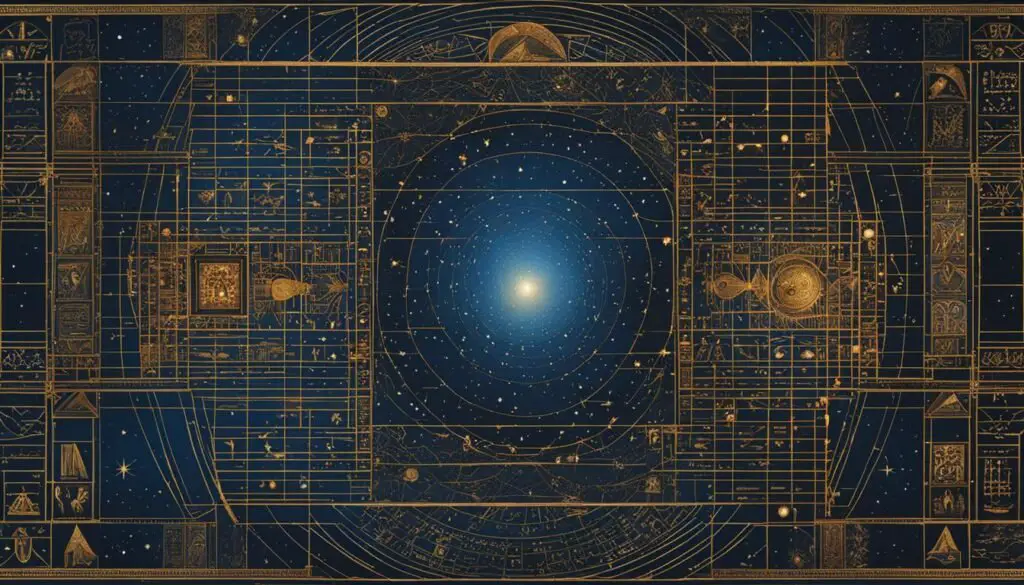
Ancient Egyptian star charts were meticulously structured, reflecting the Egyptians’ advanced understanding of celestial movements. These charts were organized into columns and rows, with each column representing a week and each row representing an hour of the night. This intricate layout allowed for precise tracking and observation of the stars throughout the year.
The most significant feature of these star charts was the inclusion of decans. Decans were individual stars or small clusters of stars that rose over the eastern horizon during specific periods. The Egyptians divided the year into 36 decans, each corresponding to a 10-day period. These decans were critical in tracking the passage of time and predicting astronomical events.
One fascinating aspect of the ancient Egyptian star charts was the presence of a triangle formed by three decans. This triangle symbolized the careful observation and recording of astronomical phenomena, confirming that these star charts were not merely symbolic representations but based on real observations.
The complexity of the ancient Egyptian star charts demonstrates the Egyptians’ extensive knowledge of astronomy. It is evident that they possessed a sophisticated understanding of celestial patterns and used this knowledge to navigate their lives and religious practices.
Debates and Challenges in Understanding the Ancient Egyptian Star Charts

Interpreting the ancient Egyptian star charts has presented scholars with a myriad of challenges. One of the key complexities is the existence of two distinct groups of star charts that exhibit different decan patterns. This raises questions about the purpose and meaning behind these variations, as well as the factors that influenced their creation.
Another challenge lies in the inconsistencies found within the chart patterns themselves. The order of appearance of certain decans differs between the two groups, adding to the complexity of understanding these ancient astronomical records. The discrepancies in the arrangement of these celestial entities leave researchers grappling with alternative explanations and the significance of these variations.
Despite these hurdles, scholars continue to investigate and analyze the ancient Egyptian star charts in search of answers. By comparing and contrasting the patterns, deciphering the symbolism, and examining the historical context, they hope to unravel the mysteries contained within these ancient artifacts. Through their diligent efforts, a deeper understanding of ancient Egyptian astronomy and its connection to their cosmology may emerge.
Here, an image of one of these star charts is displayed, providing a visual representation of the complexity and intrigue surrounding these ancient records. The chart serves as a tangible artifact that encapsulates the challenges faced in comprehending the ancient Egyptians’ knowledge of the stars and the cosmos.
Conclusion
In conclusion, the ancient Egyptian star charts provide a fascinating glimpse into the knowledge and understanding of astronomy in ancient Egypt. These charts not only reflect the Egyptians’ fascination with the stars but also highlight their complex belief systems and scientific observations.
However, interpreting these ancient astronomical records poses several challenges and debates among scholars. The existence of different decan patterns and inconsistencies in chart patterns raise questions about the purpose and variations in these star charts.
Nevertheless, further research and analysis hold the potential to unravel the mysteries of these ancient astronomical records and shed light on the ancient Egyptians’ deep understanding of the universe. By delving deeper into these star charts, we can gain valuable insights into the ancient Egyptian civilization and their unique perspectives on the cosmos.
FAQ
How many realms are there in Egyptian mythology?
In Egyptian mythology, there are multiple realms or dimensions beyond the mortal world, each represented by different gods and goddesses.
What is the role of gods and goddesses in Egyptian mythology?
The gods and goddesses in Egyptian mythology represent various aspects of life and nature and are worshipped and sought after for guidance in matters of life and death.
What is the significance of demons in Egyptian mythology?
Demons in Egyptian mythology, such as Ammut and Apepi, were powerful beings, though not as powerful as the gods. They played important roles in the afterlife and were associated with devouring the hearts of the wicked or as enemies of the sun god.
How are Egyptian gods and goddesses depicted?
Egyptian gods and goddesses are often depicted with a combination of human and animal features. They are associated with specific animal species and portrayed with a human body and an animal head.
Who are some of the major gods and goddesses in Egyptian mythology?
Some of the major gods and goddesses in Egyptian mythology include Amun, Ra, Osiris, Isis, Horus, Hathor, Anubis, Seth, Nut, and Geb. Each represents different aspects of life and nature.
What are ancient Egyptian star charts?
Ancient Egyptian star charts are records of astronomical observations, depicted on various artifacts like coffin lids. They show the movements of stars throughout the year.
What was the function of ancient Egyptian star charts?
There are different theories about the function of ancient Egyptian star charts. Some propose they were used as star clocks to determine time during the night, while others suggest they were related to religious rituals reflecting the sun’s journey through the night.
How were ancient Egyptian star charts structured?
Ancient Egyptian star charts were organized into columns and rows, with each column representing a week and each row representing an hour of the night. They included individual stars or small clusters of stars called decans.
What are the challenges in understanding ancient Egyptian star charts?
Interpreting ancient Egyptian star charts poses challenges due to the existence of two distinct groups with different decan patterns and variations in the order of appearance of some decans.
What do ancient Egyptian star charts reveal about their knowledge of astronomy?
Ancient Egyptian star charts provide valuable insights into their knowledge of astronomy and their fascination with the stars. They demonstrate the complex belief systems and scientific observations of ancient Egyptian civilization.


